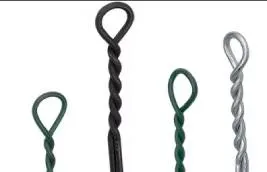-
 Phone:
Phone: -
 Email:
Email:

Understanding the Benefits and Uses of Concrete Tie Wire in Construction Projects
The Versatility and Importance of Concrete Tie Wire
Concrete tie wire, often referred to as rebar tie wire, is an essential component in the construction industry, especially in the field of reinforced concrete. This slender, flexible wire is used to secure and support reinforcement bars (rebar) in a concrete structure, ensuring that the concrete performs its function of bearing loads effectively. Despite its simplicity, concrete tie wire plays a critical role in the overall strength and integrity of concrete structures. In this article, we will explore the various applications, benefits, and considerations surrounding concrete tie wire.
Applications of Concrete Tie Wire
Concrete tie wire is primarily utilized in the construction of various structures that require reinforced concrete, such as bridges, buildings, foundations, and highways. Its primary function is to hold the rebar in position before and during the pouring of concrete. This ensures that the rebar remains properly aligned, allowing the concrete to bond effectively and distribute loads evenly across the structure.
The wire is typically made of high-strength steel, which provides the tensile strength necessary to keep the rebar securely in place. Construction workers use tie wire to create intricate geometries and ensure that the rebar elements are appropriately spaced. This specificity is crucial, as improper placement can lead to weak points in the concrete, undermining the structure's stability.
Benefits of Concrete Tie Wire
1. Strength and Durability The use of high-quality steel ensures that concrete tie wire can withstand the rigors of construction. It resists bending and breaking, maintaining the shape and integrity of the rebar framework.
2. Cost-Effectiveness Concrete tie wire is relatively inexpensive compared to other construction materials. Its low cost makes it an economical choice for securing rebar in large projects, where significant quantities are required.
3. Ease of Use The lightweight nature of concrete tie wire allows for easy handling and installation. Construction workers can quickly cut, bend, and tie the wire, facilitating an efficient workflow on-site.
4. Adaptability Concrete tie wire can be easily adjusted and repositioned to accommodate changes in design or site conditions. Its flexibility means that it can adapt to various types of rebar configurations without compromising integrity.
concrete tie wire

5. Promotes Proper Bonding By ensuring that the rebar is positioned accurately, tie wire promotes optimal bonding between the concrete and the steel. This bond is essential for enhancing the load-bearing capacity and overall performance of the concrete.
Considerations in Using Concrete Tie Wire
While concrete tie wire is a small component, it is essential to follow certain guidelines to maximize its effectiveness
1. Correct Gauge The gauge of the tie wire must match the rebar size and spacing. Thicker wires can provide better support but may also add unnecessary weight to the structure.
2. Proper Tying Techniques Workers should be trained in the correct methods of tying rebar with concrete tie wire. Inefficient tying can lead to misaligned rebar, adversely affecting the structural integrity.
3. Corrosion Resistance In certain environments, using galvanized or epoxy-coated tie wire can provide additional protection against corrosion, especially in areas exposed to moisture or chemicals.
4. Safety Precautions Handling tie wire requires safety measures to prevent injuries. The sharp ends of cut wire can pose risks, so proper tools and gloves should be employed during the process.
Conclusion
Concrete tie wire, though less visible once the concrete hardens, is a vital element of construction that contributes significantly to the safety and longevity of structures. Understanding its applications, benefits, and the careful considerations necessary for effective use ensures that construction projects can achieve their intended goals without compromising structural integrity. As the industry continues to evolve, the importance of reliable materials like concrete tie wire remains ever relevant, underscoring the careful balance between innovation and tradition in building practices.
-
Wire Mesh for Every Need: A Practical SolutionNewsJul.25,2025
-
Steel Fences: Durable, Secure, and Stylish OptionsNewsJul.25,2025
-
Roll Top Fencing: A Smart Solution for Safety and SecurityNewsJul.25,2025
-
Cattle Farm Fencing Solutions for Maximum SecurityNewsJul.25,2025
-
Affordable Iron Binding Wire SolutionsNewsJul.25,2025
-
Affordable Galvanized Wire SolutionsNewsJul.25,2025
-
Wire Hanger Recycling IdeasNewsJul.25,2025








